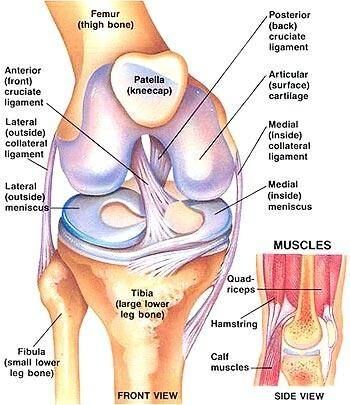Overview
Ligaments are strong bands of tissue that connect the bones in your body.
There are four ligaments in the knee:
- Anterior cruciate ligament (see cruciate ligament)
- Posterior cruciate ligament (see cruciate ligament)
- Lateral collateral ligament
- Medial collateral ligament
The ligaments of the knee connect the thigh bone (femur) and the shin bone (tibia). They help to stabilise the knee and keep the knee joint together.
What are the collateral ligaments?
The collateral ligaments are found on the inside (medial collateral) and the outside (lateral collateral) of the knee joint.
A collateral ligament is not a single ligament but rather, many small ligaments in layers that mesh together into one strong ligament.

Causes
A collateral ligament injury may occur when the knee is strained by a sideways force on the inside or outside of the knee. Collateral ligament injury may also occur in connection with a twist of the knee joint without any external pressure being applied.
Extent of ligament damage can vary from just a small crack in one of the small ligaments to total rupture of the medial or lateral collateral ligaments.
Symptoms
- Popping sensation – may be felt or heard in the knee at the time of injury. This doesn’t happen to everyone
- Pain – levels of pain vary between individuals and may come and go
- Swelling – usually occurs a few hours after injury
- Knee instability – may give trouble weight baring or walking on affected leg
Treatment
In the first 48 – 72 hours after injury think of:
Paying the PRICE
- Protect your injured knee
- Rest: using a crutch may help keep weight off your knee
- Ice: applied for 10-30 minutes at a time. Wrap ice in a plastic bag or towel to prevent ice-burn.
- Compression: a tubular bandage may be helpful. Should not be too tight or worn at night. Only to be used in first 48 hours.
- Elevation: reduces swelling. Prop up legs using a pillow when sitting or lying in bed. Aim to keep above the level of the heart.
Do no HARM – no Heat, Alcohol, Running or Massage
Further treatment depends on the severity of ligament damage. Non-surgical management of minor injuries includes:
- Physiotherapy – to strengthen the muscles supporting the knee
- Knee supports and braces
- Painkillers: paracetamol and non-steroidal anti-inflammatory medicines should be used with guidance from your general practitioner or pharmacist.
In injuries where the ligament is completely ruptured surgical repair or reconstruction may be required.


